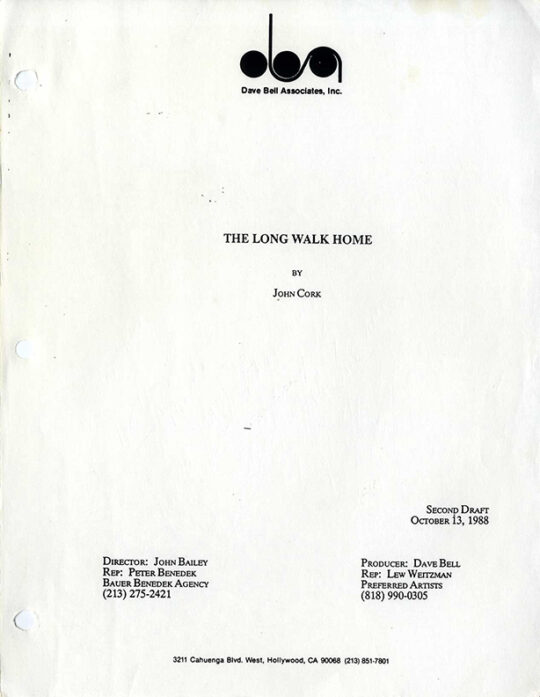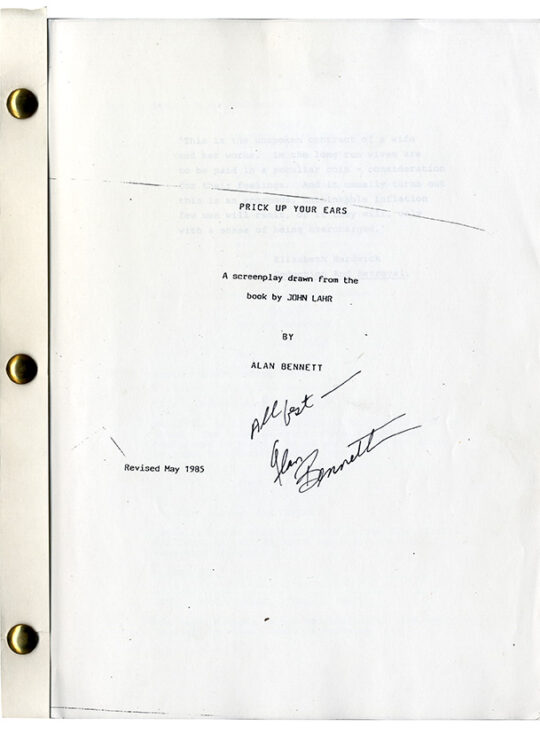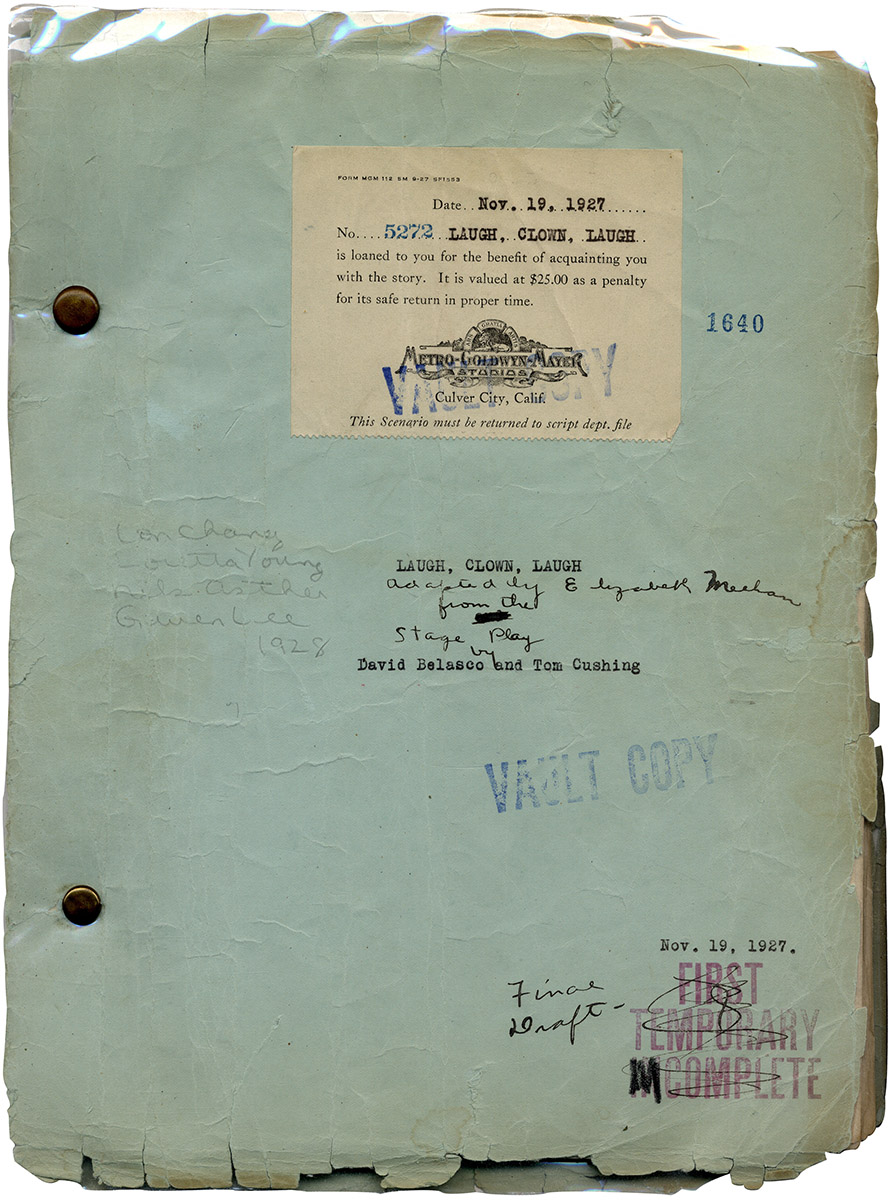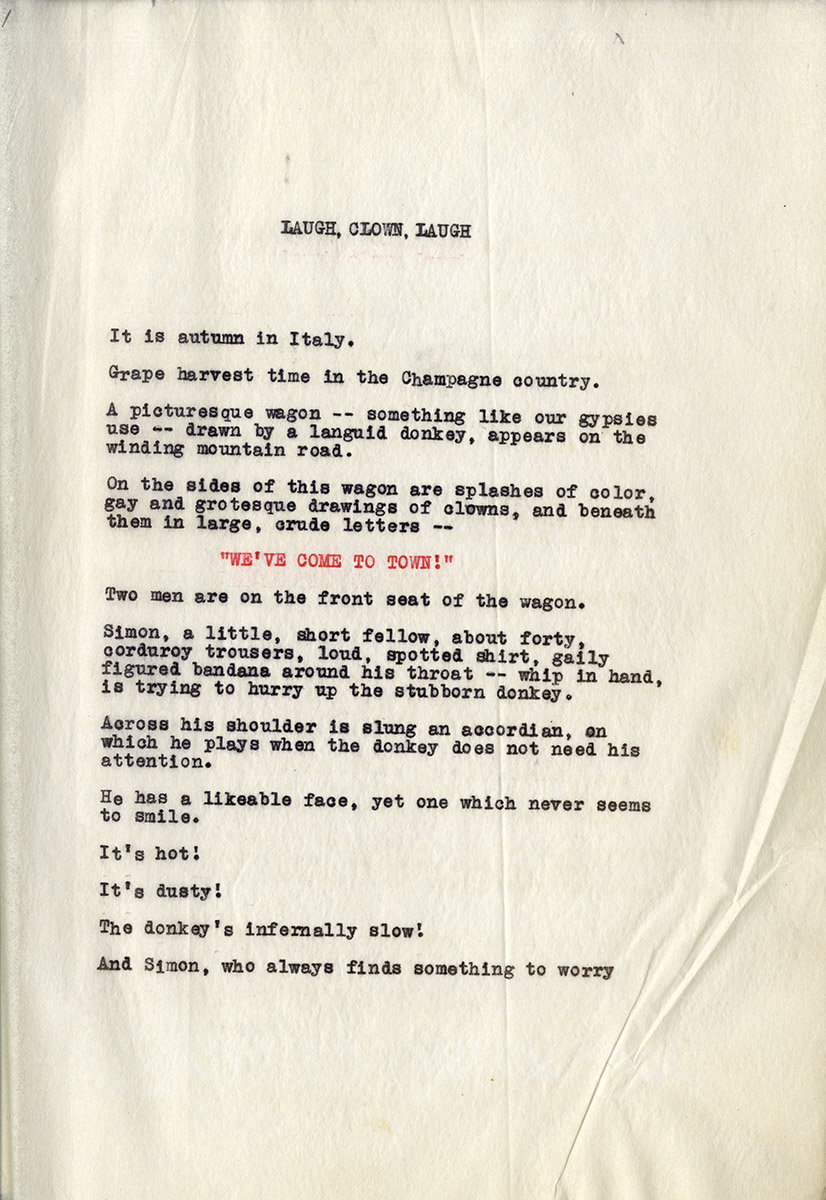Lon Chaney (actor) LAUGH, CLOWN, LAUGH (Nov 19, 1927) Film script
[Los Angeles]: MGM, 1927. Vintage original film script. Blue titled wrappers, 12 x 8 3/4″ (31 x 22 cm.), noted as FIRST TEMPORARY INCOMPLETE (and struckthrough, with “Final Draft” inscribed) on the front wrapper, rubber-stamped copy No. 1640 and production No. 5272, dated Nov. 19, 1927, with credits for playwrights David Belasco and Tom Cushing and (in ink) screenwriter Elizabeth Meehan. 73 unnumbered leaves, typescript on watermarked onionskin stock. Pages near fine, wrappers good+, split at the spine (now encapsulated in mylar) and with the normal chipping at yapped edges, brad bound.
Lon Chaney didn’t just want to scare audiences; he wanted to make them cry, and Laugh, Clown, Laugh (Herbert Brenon, 1928) is one of his most effective tearjerkers. In Laugh Clown, Laugh, Chaney plays a tragic clown. He had already played a clown to great acclaim four years earlier in He Who Gets Slapped (1924), directed by the Swedish master, Victor Sjöström.
The viewers of Laugh, Clown, Laugh got to see Chaney in several different make-ups, starting as a young Italian man, later as older versions of that character, along with two distinct clown make-ups, reflecting the narrative’s 17-year time span. The story begins with Tito (Chaney) and his brother Simon (Bernard Siegel) as two traveling clowns, sans makeup, touring the countryside in a little wagon, like the traveling performers in Fellini’s La Strada. Along the way, Tito finds an abandoned baby girl whom he decides to adopt, naming her Simonetta.
A dozen years or so years later, Simonetta has grown into a luminescent, beautiful young woman played by Loretta Young. She catches the eye of the handsome, aristocratic Count Luigi played by Nils Asther. Though this was Loretta Young’s first “adult” lead, she had already acted in at least ten prior films, having made her first screen appearance at the age of three. The screenplay of Laugh, Clown, Laugh was by British-born Elizabeth Meehan, who had previously adapted director Brenon’s silent version of The Great Gatsby (1926).
Tito, now one of the most successful clowns in Europe, visits a Viennese neurologist to find out why he is subject to uncontrollable fits of crying. The audience knows it is because Tito is hopelessly in love with Simonetta, his adopted daughter. There, Tito meets and befriends Count Luigi, who is visiting the neurologist because he is subject to uncontrollable fits of laughter. A triangle develops between Tito, Luigi, and Simonetta. She would like to accept Luigi’s proposal of marriage, but doesn’t want to leave Tito whom she knows is also in love with her. To clear the way for the two young lovers, Tito deliberately kills himself while rehearsing a high-wire act.
Laugh, Clown, Laugh was a tour-de-force for actor Chaney. As a clown, he gets to show off his gifts for comedy, acrobatics and pantomime. As a man, yearning after an impossible love, he shows off a full range of tragic emotions. The film further benefits from Herbert Brenon’s polished direction, Cedric Gibbons’ production design, and cinematography by the brilliant James Wong Howe.
According to Wikipedia and other sources, the existing print of Laugh, Clown, Laugh “is not 100% complete; it is missing reel #4, but the missing footage does not severely impact the story.” This makes the written screenplay particularly valuable to film scholars as a documentation of everything that is now missing.
Out of stock
Related products
-

Carson McCullers (source) THE HEART IS A LONELY HUNTER (Aug 26, 1963) Film script by Thomas C. Ryan
$1,000.00 Add to cart -

LONG WALK HOME, THE (Oct 13, 1988) Second draft film script by John Cork
$375.00 Add to cart -

(African American film) A PIECE OF THE ACTION [working title: SOMETHING BIG COMING UP] (Nov 1, 1976) Film script
$750.00 Add to cart -

PRICK UP YOUR EARS (May 1985) Revised film script
$650.00 Add to cart


